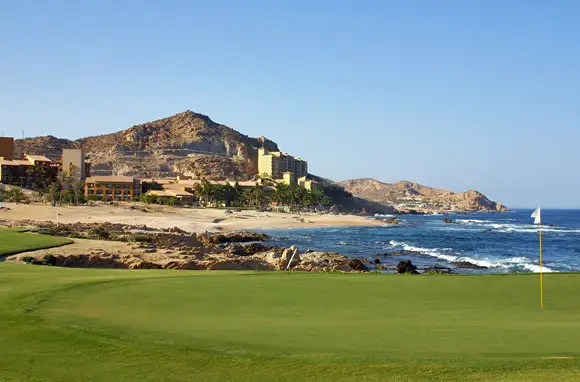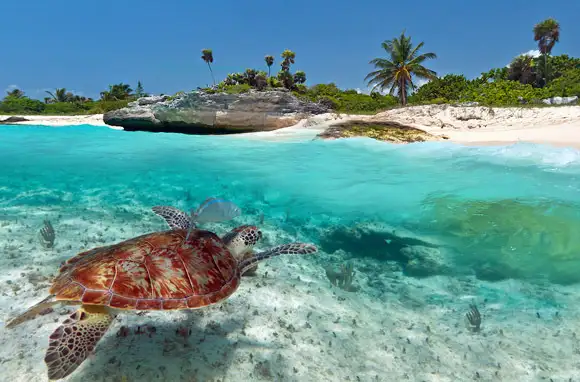
From archaeological wonders to world-class beaches to the second-largest barrier reef in the world, Mexico has something for everyone. But in a country roughly three times the size of Texas, how do you plan the right vacation for your personal interests? Take a look at the best of Mexico’s Caribbean and Gulf of Mexico side compared to its best offerings on the Pacific and Sea of Cortez side—and then decide for yourself.
Image Gallery

Archaeology
Picture this: You're walking through the jungle when suddenly the trees open before you to reveal sacred temples from another time. Or, you're in an open-air museum, admiring how some of the first artists depicted their everyday settings in colorful murals. Either experience can be yours, depending on which coast you choose to visit.
The West
As many as 400 pre-Hispanic cave-painting sites have been found along various points in Baja California Peninsula's central and northern sections, namely Cueva de Palma, San Gregorio, Sierra de Guadalupe, and especially Sierra de San Francisco—the latter a UNESCO World Heritage site. While historians dispute who created these marvels and when, some estimates date the rock art as far back as 7,500 years and suggest that the art was likely produced by nomadic hunter-gatherer tribes. The murals vary but oftentimes depict colorful wildlife and hunting scenes.
Among one of the more popular works is El Diablito, or Little Devil. In the morning light of the winter solstice, this strategically placed piece gives the illusion that the devil's eyes are illuminated.
Hiking to these sites ranges from easy to difficult, depending on the mural's accessibility.
The East
The Yucatan Peninsula is home to some of the world's most widely known archaeological sites, including the uber-popular Maya ruins at Chichen Itza and Tulum. Easily accessible from the nearby resort corridor, these cultural sites are worlds away from the all-inclusive lifestyle.
Equidistant from Cancun and Merida lies one of the New7Wonders of the World, Chichen Itza. This archaeological wonder is one of the most-visited and best-maintained Maya cities. The site's most prominent structure, El Castillo (or "castle"), is a pyramid featuring 365 steps and 52 panels. During the vernal and autumnal equinoxes, the sun's shadow lines up with the large carving of a reptile head at the foot of the Castillo pyramid to form an enormous snake.
Set atop tall cliffs overlooking the Caribbean Sea is the walled city of Tulum. Though structurally smaller than nearby Chichen Itza, Tulum is still a popular destination, in particular because of its proximity to Cancun—about a two-hour drive—and because of its seaside location. Bring your swimsuit when exploring this ruin, as Tulum is the only pre-Columbian archaeological city built on the coast.
The archaeologist in you will be satisfied with more than 30 known Maya ruins in Campeche, Quintana Roo, and Yucatan—the three Mexican states that make up the Yucatan Peninsula.

Archaeology
Picture this: You're walking through the jungle when suddenly the trees open before you to reveal sacred temples from another time. Or, you're in an open-air museum, admiring how some of the first artists depicted their everyday settings in colorful murals. Either experience can be yours, depending on which coast you choose to visit.
The West
As many as 400 pre-Hispanic cave-painting sites have been found along various points in Baja California Peninsula's central and northern sections, namely Cueva de Palma, San Gregorio, Sierra de Guadalupe, and especially Sierra de San Francisco—the latter a UNESCO World Heritage site. While historians dispute who created these marvels and when, some estimates date the rock art as far back as 7,500 years and suggest that the art was likely produced by nomadic hunter-gatherer tribes. The murals vary but oftentimes depict colorful wildlife and hunting scenes.
Among one of the more popular works is El Diablito, or Little Devil. In the morning light of the winter solstice, this strategically placed piece gives the illusion that the devil's eyes are illuminated.
Hiking to these sites ranges from easy to difficult, depending on the mural's accessibility.
The East
The Yucatan Peninsula is home to some of the world's most widely known archaeological sites, including the uber-popular Maya ruins at Chichen Itza and Tulum. Easily accessible from the nearby resort corridor, these cultural sites are worlds away from the all-inclusive lifestyle.
Equidistant from Cancun and Merida lies one of the New7Wonders of the World, Chichen Itza. This archaeological wonder is one of the most-visited and best-maintained Maya cities. The site's most prominent structure, El Castillo (or "castle"), is a pyramid featuring 365 steps and 52 panels. During the vernal and autumnal equinoxes, the sun's shadow lines up with the large carving of a reptile head at the foot of the Castillo pyramid to form an enormous snake.
Set atop tall cliffs overlooking the Caribbean Sea is the walled city of Tulum. Though structurally smaller than nearby Chichen Itza, Tulum is still a popular destination, in particular because of its proximity to Cancun—about a two-hour drive—and because of its seaside location. Bring your swimsuit when exploring this ruin, as Tulum is the only pre-Columbian archaeological city built on the coast.
The archaeologist in you will be satisfied with more than 30 known Maya ruins in Campeche, Quintana Roo, and Yucatan—the three Mexican states that make up the Yucatan Peninsula.

Snorkel and Dive
Dive into the water to discover another world, one rich in marine wildlife, colorful coral, and hidden water-filled caves. Snorkel or dive: Mexico's rich east and west shorelines have dive sites for days.
The West
The waterway between the Mexican mainland and the Baja Peninsula is known as the Sea of Cortez or, as oceanographer Jacques Cousteau dubbed it, "the world's aquarium." In these deep waters, ancient corals shelter diverse marine life, among it more than 220 fish species, plus sea turtles, dolphins, sea lions, and various sharks. The Sea of Cortez is also the breeding ground for humpback, blue, and gray whales, as well as great-white and whale sharks—the largest fish in the world.
This fertile sea is known for hosting an abundant selection of water activities like diving, sea kayaking, and whale watching (most popular during the calving season from early winter through March). It also hosts as many as six international sport-fishing tournaments out of Los Cabos. For a more intimate wildlife experience, take an exhilarating swim with whale sharks. From June through September, help along baby sea turtles as they take their first challenging steps from their beachside nests into the water, all the while evading predatory birds.
The East
Second largest only to Australia's Great Barrier Reef, the Mesoamerican Reef stretches nearly 700 miles from the Yucatan Peninsula to the Honduran Bay Islands and is the largest coral reef in the Western Hemisphere. The reef system is home to more than 150 species of fish and almost 100 coral species.
Puerto Morelos, Isla Mujeres, and Cozumel—all brief boat rides away from Cancun—are known for their shallow reefs, mild currents, and colorful marine life. Not to be missed are dives into any of the more than 2,000 cenotes in the Yucatan Peninsula. These underwater caves offer views of seldom-seen life surrounded by stalactites and stalagmites.
The warmest waters are from June through November, which also coincides with the region's hurricane season.

Affordability
Mexico's western side is most affordable for those heading southbound from the West Coast of the United States and is less so for those coming from the East Coast. Round-trip flights are generally about $250 from the West Coast and about $700 from the East Coast—a considerable difference. The converse is true for Mexico's Caribbean side, which tends to attract vacationers from the East Coast because of its similarly affordable airfares.
The West
Google "celebrities" and "Cabos" and you'll get a who's who of Hollywood names in your search results. And it's not only its proximity to the Golden State that draws Tinseltown A-listers to Baja California Sur. Virtually everyone speaks English, and U.S. currency is universally accepted. Convenience has a price, though, and Los Cabos is not cheap. Tucked-away luxury resorts are commonplace and rooms fetching upwards of $500 per night aren't uncommon, either.
The East
As a general rule of thumb, competition drives down rates, and with more than 32,000 hotel rooms on the 17-mile stretch of Cancun's Caribbean and Nichupte Lagoon and more than 38,000 rooms in the Riviera Maya zone, hotels are very affordable here. There are plenty of all-inclusives offering meal and drink plans that make for a cost-efficient proposition for budget-minded vacationers.

Weather
A destinationâs weather can play an important role on your vacation—it can either enhance a pleasant vacation or cause inconvenience and even unpredictable havoc. While weather on both of Mexicoâs coasts is agreeable for the majority of the year, make sure to take seasonal variations into account when vacation planning.
The West
The western side of Mexico boasts a (generally) pleasant and arid climate. Hurricanes don't touch this region, but scorching heat does in the dog days of summer. July through September is the hottest time here (locals in the tourism industry call the ninth month "Septihambre," a play on words describing September as a famished season).
The East
The Yucatan's climate is enjoyable year-round, but the region experiences hurricane season from June to November, with most storms striking from August to October.
Hurricane season, however, shouldn't necessarily be avoided. This time also coincides with low crowds and great values on flights, accommodations, and activities. Consider travel insurance if you're visiting during this season.

Safety
With mounting news about violence in Mexico these days, there's a lot of talk about whether it's safe to visit our southern neighbor. So, is it safe to travel to Mexico right now? In short, yes, but not everywhere.
Mexico is among those countries listed in the U.S. State Department's (DOS) Travel Warnings and Alerts. With a country the size of Mexico, however, the range of destinations is broad while the violence is fairly localized to a few small areas. The majority of Mexico's violent acts tend to be drug related and generally occur along the U.S. border, infrequently impacting the tourists. More than 23.4 million people can't be wrong! That's the number of international visitors the country was host to in 2011.
The West
The DOS reports that there is no travel advisory in effect in Baja California Sur, home to Los Cabos, La Paz, and Todos Santos. Puerto Vallarta and Guadalajara also aren't on the travel-advisory list. Further south, the State Department warns that Acapulco, Ixtapa, and Zihuatanejo are safe for travel, but that caution should be exercised when traveling outside of tourist areas at night.
The East
On the Yucatan Peninsula, the Mexican states of Yucatan (Merida and Chichen Itza), Quintana Roo (Cancun, Cozumel, Playa del Carmen, Tulum, and the Riviera Maya), and Campeche are excluded from the travel-advisory list. In general, tourists tend to fall prey to pickpockets and are rarely victims of violent crimes, and wallets or cameras can be stolen in just about any destination. Common sense is your best tool to avoid trouble.

Golf
Every amateur golfer has his or her favorite course, but those who get paid to putt are experts at deciphering what makes for an excellent golf course. Which green should you pay good green for?
The West
Los Cabos is an up-and-coming star destination for golf vacations, and it has several world-championship golf courses to prove it. Professionally designed courses by Jack Nicklaus, Pete Dye, Greg Norman, and an upcoming course by Tiger Woods—his first ever—are all within, ahem, driving distance of each other.
Four courses on the western shores of Mexico made Golf Digest's "100 Best Courses Outside of the U.S." list. Among the Mexican greens listed, three are in the Los Cabos: Diamante Golf Club, Cabo del Sol, and El Dorado Golf & Beach Club. The Four Seasons Golf Club in Punta Mita, Nayarit, (north of Puerto Vallarta) is also listed among the 100 top courses.
The East
If golf is a "must" activity on your vacation, look elsewhere. The eastern half of Mexico doesnât boast a single course that made Golf Digest's top-100 list.

Party
Mexico hosts more than 100,000 American high-school and college students every year. Why? Two words: spring break.
The West
Revelers rejoice, there is no need to wait for a school break to party in Cabo. Heck, you don't even have to be in school. Mostly within stumbling, err, walking distance from each other, El Squid Roe, Sammy Hagar's Cabo Wabo Cantina, Mandala, and Pink Kitty are but a few of the clubs lining up the tequila any day of the year in Cabos. Body shots, anyone?
Seeking the sun and not that type of fun? San Jose del Cabo is the more sophisticated of the Cabos, with Cabo San Lucas seeing the majority of its partiers and even then, mostly only during spring-break season from January through April.
The East
Cancun is widely regarded as the number-one spring-break destination, and the Cancun tourism board expects as many as 43,000 spring breakers this year. Teenagers are attracted to the hopping nightlife; the affordable accommodations, especially at all-inclusive resorts (which include all the beverages one can consume—wink, wink); the clothing-optional beaches and resorts; and (for some) the nearby archaeological marvels.
Los Cabos and Cancun tend to top the list of party destinations in Mexico, in particular for the college set, but other cities on the list are Puerto Vallarta, Playa del Carmen, and Acapulco (though the latter has recently seen some unrest).

Beaches
With so many glorious beaches in Mexico, you might think it would be hard to declare either coast a winner in this category. However, unfortunately for the western portion of Mexico, its overpowering waves and undertow make the choice between the Pacific and Sea of Cortez versus the Gulf of Mexico and Caribbean an easy one.
The east's temperate weather and winds keep the sea tranquil and enjoyable—perfect for snorkeling and bathing.
Many beaches on the west have posted signs warning swimmers, surfers, and snorkelers to heed warnings and build sand castles instead.
âNuff said.
More From Smartertravel:
We hand-pick everything we recommend and select items through testing and reviews. Some products are sent to us free of charge with no incentive to offer a favorable review. We offer our unbiased opinions and do not accept compensation to review products. All items are in stock and prices are accurate at the time of publication. If you buy something through our links, we may earn a commission.
Related
Top Fares From
Today's Top Travel Deals
Brought to you by ShermansTravel
Shop and Save with Country Inns...
Patricia Magaña
 Hotel & Lodging Deals
Hotel & Lodging Deals
$229 -- Chicago: Discounted Rates and...
Francesca Miele
 Hotel & Lodging Deals
$229+
Hotel & Lodging Deals
$229+
$188 -- Honolulu: Save on Oceanview...
Abigail Lamay
 Hotel & Lodging Deals
$188+
Hotel & Lodging Deals
$188+



